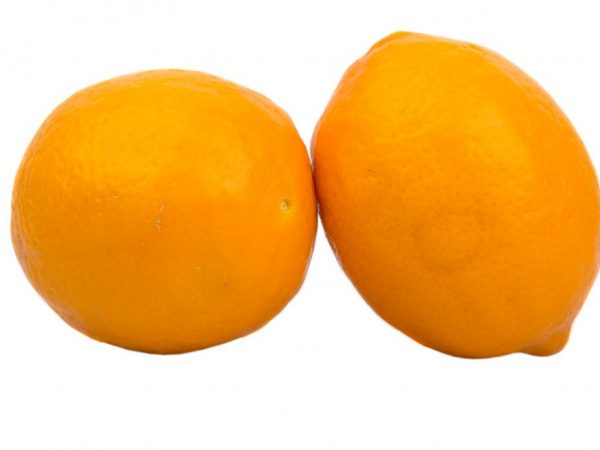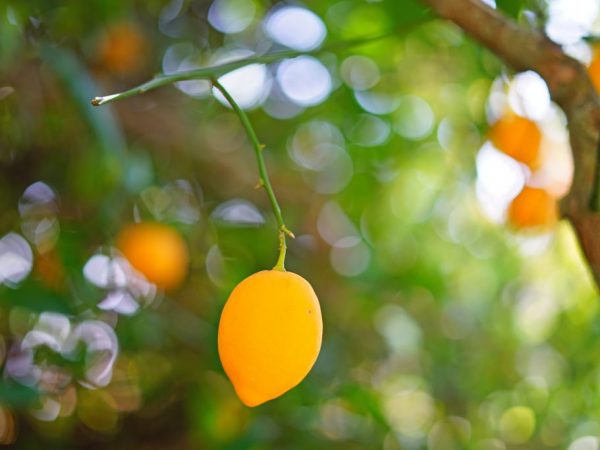Meyer's orange lemon
One of the most unusual types of citrus fruits is considered to be a hybrid of lemon and orange - an orange lemon called Meyer.

Meyer's orange lemon
Characteristic
Many of our favorite fruits are hybrids. Orange lemons are a cross between citrus and orange. It is named after Meyer, who first bred this variety. Such citrus is almost impossible to find on store shelves; it is most often grown at home.
Description of fruits
Meyer's fruits are small, round in shape, weigh about 100 g. Citrus bears fruit several times a year, it is possible to collect from 3 kg of harvest.
The rind is either yellowish or orange in color, but the flesh is always bright orange.
Outwardly, Meyer resembles an orange, but tastes like a lemon. The crossing was with an orange, so the citrus is not as sour as the rest of the representatives. This is due to the fact that the chemical composition of the juice is 3-6% less acid, while fructose, on the contrary, is 10-12% more.
In the common people, the variety is sometimes called "Meyer's lemon-orange".
Description of the bush
The bush reaches 2 m in height. The leaves are oval. Despite its exotic origin, this citrus variety is resistant to frost and changes in weather conditions.
During flowering, small white flowers with a pleasant aroma appear on the plant.
Growing
Growing an orange lemon at home is easy. It is grown both in specially equipped greenhouses and in an ordinary apartment. The main thing is to observe the temperature regime, to carry out the correct watering, to apply fertilizers on time.
Although the lemon can withstand temperature changes, too low can ruin the plant. The orange colored lemon needs sunlight, but the direct rays burn the leaves on the bush, so the light should be diffused.
Landing in the soil
Most often, orange lemons are grown in pots, extremely rarely - they are planted in open ground. The planting container should be 15 cm high and wide. Any material can be chosen:
- plastic;
- ceramics;
- wood;
- metal.
Properly prepared soil is important for planting. At the bottom of the container, a drainage of sand and ash is placed in layers. The soil is also made independently. This requires:
- river sand;
- the top layer of earth from the forest;
- humus;
- wood ash.
If it is not possible to make it yourself, the soil is bought in specialized stores. The soil mixed with water is poured into a pot with a bush. After 6 months, the plant is transplanted into a larger pot.
Care

The plant is watered only with warm water.
Orange lemons do not require frequent watering.
In winter, one per week is enough, in a hotter period it will have to be produced every day.
Tap water can destroy the plant; for irrigation, you should take water from a well or take it from a well. The water temperature should always be warm, from 30 ° C to 35 ° C. Citrus is occasionally sprayed.
The optimum temperature for citrus development is 18 ° C-20 ° C.Too high, as well as too low an indicator, leads to the death of the plant, so a windowsill or balcony will not be the best place to grow a bush.
Fertilizer
Like any indoor plant, the orange lemon needs feeding. The bush begins to fertilize in the 2nd month after planting. Fertilizers are applied once a week. Top dressing is purchased at the store and applied to wet soil. In the spring, the plant is fertilized with ferrous oxide. In the autumn period, feeding is reduced, the plant is watered with black tea.
Diseases and pests
Citrus gets sick for a number of reasons, including:
- contaminated soil or container;
- improper watering;
- lack of nutrients in the soil;
- infection from nearby plants.
The citrus tree most often suffers from viral or fungal diseases: from root rot and gommosis.
The plant attacks aphids, spider mites, scale insects.
Fight disease
When affected by a fungal disease, all damaged areas of the bush are removed, the plant itself is treated with 5% Bordeaux liquid.
Infections and root rot will have to tinker with. The plant is pulled out of the pot, completely free from the soil. After the citrus is placed in a solution of potassium permanganate for several hours. All rotten and affected areas are removed. The container is sterilized and then new soil is placed.
Pest control
In the fight against pests, chemicals such as "Akrata" and "Fitosporin" are most often used. Folk remedies are also used. The plant is sprayed with soapy water, boric acid or garlic water. After the operations, the bush is placed under a warm shower.
Prophylaxis
For the prevention of diseases and pests, watering rules are observed. Too abundant leads to root rot, and insufficient to pest damage.
It is also important to inspect the leaves and soil in a timely manner and periodically spray the citrus with chemicals.
Conclusion
Meyer's orange lemon is one of the most exotic and delicious indoor plants. It will not be difficult to grow it at home. Meyer is able to decorate the interior of any room.


